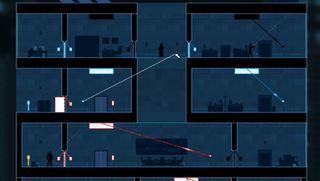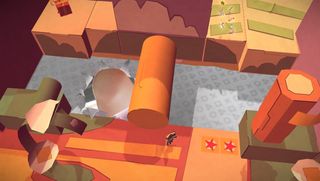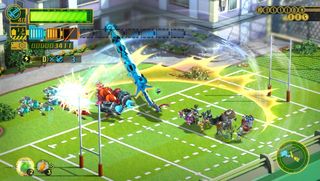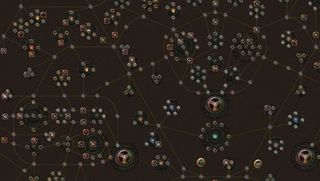Merging with walls in painting form (The Legend of Zelda: A Link Between Worlds)

Link's adventures have always been rife with ingenious dungeon puzzles and inventive methods of traversal. But the power to shift onto walls in A Link Between Worlds added another wrinkle to Link's top-down adventures, changing the way we looked at the environments both literally and figuratively. It took some getting used to, but once we realized that pits and barricades were surmountable obstacles in the 2D plane instead of dead-ends, our approach to dungeon puzzles got flipped on its head. Slipping behind paintings, ducking into walls to avoid damage, and wriggling through trans-dimensional cracks in the faces of mountains were all refreshing modes of travel, in that magical only-in-Zelda kind of way.
Rewiring levels with the Crosslink device (Gunpoint)

Your typical stealth game will talk up a lot of emergent gameplay--but when you're actually slinking through the shadows, you realize that the developers laid out a very set path for the player. Not so with Gunpoint, which lets you restructure levels down to the very last light switch to suit your stealthy needs. That means the solutions to these multi-layered puzzles are as complex or simple as you make them. There's nothing quite as satisfying as rewiring a level so that your enemies end up killing themselves, in a Rube Goldberg-esque domino of guard death. Crosslink is the kind of game mechanic that really encourages creative thinking, and not in a Minecraft or Terraria kind of way.
The finger of God (Tearaway)

Sometimes, when wandering the whimsical world of Tearaway, you'll find paper that you can shove your finger through. You do this by literally putting your finger--which you've specified the color tone of at the beginning of the game--on the back touch pad, making it genuinely feel like you're shoving your digits into the digital world. That, alone, would make it worthy of being on this list, but it's the attention to detail that takes it from "interesting idea" to "HOLY WHAT," since it uses the Vita's back camera to put a little border around your finger, showing the world behind your Vita as you break through the paper. It's wow. Wooooooow.
Audio logs that play from your controller (Killzone: Shadow Fall)

Audio logs aren't anything new--in fact, they're one of the most overplayed tropes from the last generation (remind us next year to write up the Top 7 most overplayed tropes from the last generation). So when a game actually manages to surprise us with its audio logs, we pay attention. And that's just what Killzone: Shadow Fall did, by having the audio come not from our TV's speakers, but from the controller's. Sure, some Wii games did this a few years back, but hearing our DualShock 4 speak for the first time gave us a jump we won't soon forget.
Unite Morphs (The Wonderful 101)

Divided, we fall; united, we form a gigantic red fist that punches colossal aliens in the face. The Wonderful 101 demonstrates what's possible when the mob mentality works for the greater good--with a smidgen of superpowers mixed in, of course. Depending on the formation you drew on your GamePad, the noble citizens in your heroic brigade can combine into huge drills, or boomerangs, or spiked balls, or a rocket ship, or handguns, or a host of awesome transformations. It's kinda like those human pyramids you made at sleep-away camp, but ten billion times cooler.
The go-anywhere skill tree (Path of Exile)

Path of Exile is a game by Diablo fans, for Diablo fans, so of course it's going to play pretty closely to the its spiritual predecessor. But its most intriguing aspect is actually a nod to Final Fantasy X: a colossal, interconnected skill tree with limitless possibilities. Each class starts as a spoke on the passive skill wheel, but if you plan your build ahead of time, you can venture far beyond your class' standard specialties. A Ranger that tanks with evasion and a shield? A hulking Marauder that only uses wands? A spell-casting Witch with a two-handed axe? It's the actual fulfillment of a promise made by countless action RPGs: whatever character you dream up, you can build it.
Scope zeroing (Battlefield 4)

Typical video game sniper rifles work one of two ways: either they fire laserbeams that strike enemies exactly where they're aiming from any distance, or they include realistic bullet drops that force you to account for distance and stuff. Battlefield 4 adds in a new way: scope zeroing. The bullet drops, but instead of forcing you to literally train yourself in the physics of bullet velocity, you're able to adjust the scope to do that work for you. The result is being able to accurately hit enemies, while accounting for the bullet drop, from thousands of feet away--all the while feeling like an absolute baller.
Two-button, no joystick fighting (Divekick)

The fighting game genre is often maligned for being too demanding; if you don't have the wherewithal to memorize combos and execute them at the drop of a hat, you might as well just stick to being a spectator. Divekick said to hell with that, boiling 2D fighting down to its raw essence like syrup from a mound of complex sugars. The premise was pretty much the same: try to predict your opponent's next move, then punish them with a flying kick to the dome. But the input method was radically different, with a jump button, a dive button, and nothing else--not even a joystick for back-and-forth movement. It made Divekick a traditional fighter that anyone could pick up and play.
Pro Stick control (NBA 2K14)

Pro Stick control splits opinion like Jrue Holiday slicing between two lumbering defenders. While some enjoy the subtle control that mapping shooting and dribbling to the Right Thumbstick affords, others just cant adjust to the fact its very different to 2K13s set-up. Master the Pro Stick, though, and you really can play some wonderful virtual basketball. Angling your body on lay-ups is much easier, and you can chain together dribble moves with shooting, seamlessly. Those fancy moves your favorite players make--like Jamal Crawfords Shake and Bake--suddenly become a) possible and b) reasonably easy to pull off. Its not a complete success, though, which is why you can switch the Right Stick to pure dribble move in the options menu, but it is a step forward in terms of control for those savvy enough to persist with it.
Cutting your way across a level (Puppeteer)

Movement in 2D sidescrollers has already been well established at this point. You jump, you run, and in some games, you smack or blast enemies. But Puppeteer outfitted the adorable marionette Kutaro with quite the clever gizmo: the magical Calibrus shears, which doubled as a weapon and a method of locomotion. It transformed the way you moved through levels; instead of just hopping from platform to platform, Kutaro could actually cut his way over chasms and towards secrets, the magical scissors yanking him in any direction. When any piece of fabric in the background becomes a pathway to the next area, the possibilities are something quite atypical of your average platformer.
